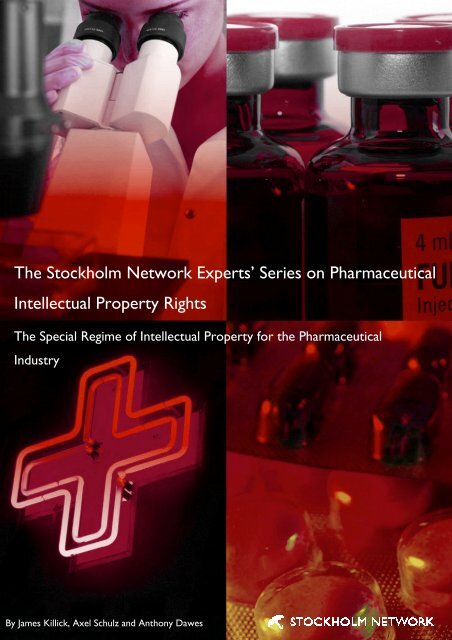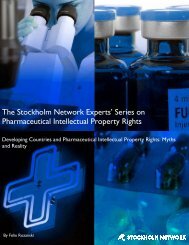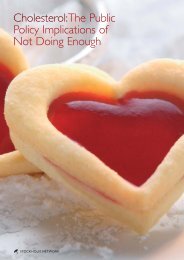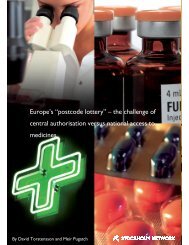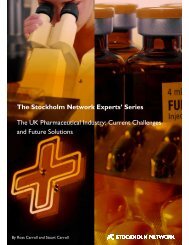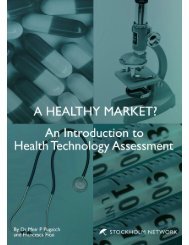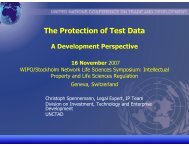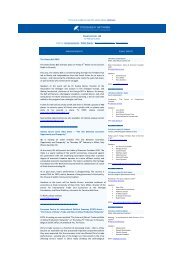Download this publication - The Stockholm Network
Download this publication - The Stockholm Network
Download this publication - The Stockholm Network
Create successful ePaper yourself
Turn your PDF publications into a flip-book with our unique Google optimized e-Paper software.
<strong>The</strong> <strong>Stockholm</strong> <strong>Network</strong> Experts’ Series on PharmaceuticalIntellectual Property Rights<strong>The</strong> Special Regime of Intellectual Property for the PharmaceuticalIndustryBy James Killick, Axel Schulz and Anthony Dawes1
<strong>The</strong> Special Regime of Intellectual Property forthe Pharmaceutical IndustryJames Killick, Axel Schulz and Anthony DawesWhite & Case, Brussels 1© <strong>Stockholm</strong> <strong>Network</strong> 2008. <strong>The</strong> views expressed in <strong>this</strong> <strong>publication</strong> are those of the authorsand do not necessarily represent the corporate view of the <strong>Stockholm</strong> <strong>Network</strong> or those of itsmember think tanks.1<strong>The</strong> views expressed are strictly personal and do not necessarily reflect those of the firm or any of its clients.2
I. Introduction<strong>The</strong> pharmaceutical industry is distinct from most other sectors in its reliance on intellectual property rights(IPRs) – and the full duration of patent protection in particular. <strong>The</strong>re are a number of reasons for <strong>this</strong> whichdistinguishes the pharmaceutical industry from other industries where a product can enter the market soonafter a patent application is made and where innovation and technological development can make patentedtechnology obsolete long before the expiry of the patent.First, there are significant regulatory and scientific requirements that must be fulfilled before any new drug canbe placed on the market. <strong>The</strong> drug must complete a rigorous testing process to establish that it is both safeand effective. It can easily take 15 years from the discovery of - and the filing of a patent application on - a newmolecule to the date that it enters the market in the EU. This delay has been steadily increasing. Today <strong>this</strong>process can take up to 15 years.Second, is the relative speed with which generic producers can enter the market once the patent has expiredgiven that they do not need to repeat the regulatory process. This means that the pharmaceutical companywhich developed the drug must plan to recoup the cost of its R&D investment before patent protectionexpires.Third, the very significant cost of developing a new drug, which today is estimated at around a billion dollars. 2This compares to approximately $230 million at the end of the 1980s. This cost includes the thousands ofdrugs that fail to make it through the R&D process – the thousands of potential molecules which are found tobe unsuitable and the promising new molecules which fail to clear the final hurdle after a decade’s worth ofwork.This article explores the unique regulatory environment of the pharmaceutical industry, with a focus on theregime in Europe. It examines two sector-specific IP rights, which are granted in the EU to compensatepharmaceutical companies for the delays inherent in the regulatory system, namely Supplementary ProtectionCertificates (SPC) and regulatory data protection, and discusses some recent cases involving SPCs. Finally, itbriefly reviews the current plans to address delays in the regulatory regime, which could, if successful, reducethe long-term need for special IP rules for pharmaceuticals.II.<strong>The</strong> regulatory hurdles for new drugsBefore any drug can be put on the market in Europe it must obtain a marketing authorisation. <strong>The</strong>re are twodifferent procedures for obtaining a marketing authorisation in Europe – the centralised and the mutualrecognition procedure.2According to a 2003 study by Bain & Company, when the costs of failed prospective drugs are factored in, the actual cost of discovering,developing and launching a single new drug has risen to nearly $1.7 billion. This represented a 55% increase over the averagecommercialization cost for the five years from 1995 to 2000. Seehttp://www.bain.com/bainweb/<strong>publication</strong>s/in_the_news_detail.asp?id=14243&menu_url=for%5Fthe%5Fmedia%2Easp. Other studiesreport figures of the same order of magnitude.3
Under the centralised procedure, the European Medicines Agency (EMEA) grants a single marketingauthorisation for a product which is valid throughout the EU. <strong>The</strong> centralised procedure is compulsory forcertain medicinal products, notably high-technology products and those containing an entirely new activesubstance.Under the mutual recognition procedure, which is still widely used where the centralised procedure is notobligatory, a pharmaceutical company obtains a marketing authorisation from one EU Member State, and thenapplies to other Member States for recognition of the authorisation, in accordance with the mutual recognitionprinciple.To obtain a marketing authorisation, new molecules must undergo extensive and highly regulated testingbefore they are approved nationally or at the European level and allowed to enter the market. <strong>The</strong> sametesting is required under the centralized and mutual recognition procedures; the only difference being theauthority to which the test results are to be presented. <strong>The</strong>re are two stages of testing: pre-clinical testing andclinical testing.Pre-clinical testing consists of laboratory and animal studies to assess the chemical, biological and toxicologicalproperties of the compound against the targeted disease. Tens of thousands of molecules may be screened tosee if they have a potential pharmacological effect. Over a period of two to three years, only a handful maymove forward for detailed pre-clinical evaluation. On average, compounds spend around four years in the preclinicalstage.Potential drugs that pass the pre-clinical testing stage will then undergo three phases of clinical trials, i.e.experiments conducted on human beings under very strict ethical and technical rules. 3In Phase I, the substance is tested on a limited number (between 20 and 100) of healthy volunteers, understrict hospital supervision. <strong>The</strong>se trials typically account for less than 10% of total R&D spending. Usuallyaround 80-90% of candidate drugs fail to make it past phase I.Phase II consists of controlled trials on approximately 100 to 500 volunteers to gather information on thesubstance’s efficacy (relation between dose and effect) and safety (identification of possible adverse sideeffects). Phase II trials typically account for around 10-15% of a pharmaceutical company’s R&D budget.Statistically, fewer than 40% of Phase II candidates will progress to Phase III.In Phase III, the remaining compounds undergo more comprehensive studies, usually involving 1,000 to 5,000voluntary patients in clinics and hospitals. Phase III investigates long-term effects and also compares theproposed new treatment with other treatments already in use. Phase III trials are often described as pivotaltrials and usually form the major part of the submission to the regulatory authorities. <strong>The</strong>y could typicallyaccount for 30-35% of a company’s R&D spending.3Directive 2001/20/EC of the European Parliament and of the Council of 4 April 2001 on the approximation of the laws, regulations andadministrative provisions of the Member States relating to the implementation of good clinical practice in the conduct of clinical trials onmedicinal products for human use, O.J. L 121, 1/5/2001 pp. 34 – 44; Directive 2005/28/EC of 8 April 2005 laying down principles anddetailed guidelines for good clinical practice as regards investigational medicinal products for human use, as well as the requirements forauthorisation of the manufacturing or importation of such products O.J. L91 , 09/04/2005 pp. 13-194
Even after a product has successfully completed at least two pivotal trials and received the approval of therelevant regulatory authority, the clinical process has not ended. Pharmaceutical companies must continue tomonitor a product for adverse reactions throughout its lifetime on the market. An adverse reaction mayoccur only rarely, meaning it was not detected in the trials, even though up to 5,000 patients may have beeninvolved. Such reactions may be detected only when the product has been used by a substantial number ofpatients. A number of products have had to be withdrawn from the market due to safety concerns, despitepassing all three phases of clinical trials.So it would be fair to say that the pharmaceutical industry operates in a strict regulatory regime, whichdifferentiates it from most other industry sectors, notably because of the lengthy delay before a patented newdrug can be placed on the market. In no other industry does it take up to 15 years from the day the patentapplication is made until the product is actually marketed.III. <strong>The</strong> SPC: A special intellectual property right for the pharmaceuticalindustryGiven the situation described above, the pharmaceutical industry argued for a special IP regime, pointing outthat the period of effective patent protection was insufficient to allow the developer of a new drug to recoverits investment in R&D. Specifically, it argued that regulatory authorisation to place the product on the marketwas granted only many years after the date on which a patent application was made. In other words, much ormost of the monopoly granted by the patent had been used up before the product could be placed on themarket.<strong>The</strong> EU responded in 1992 by adopting the Supplementary Protection Certificate (SPC) Regulation, 4 whichgrants pharmaceutical products up to five years’ extra patent protection to compensate research-basedcompanies for the delays inherent in the regulatory system. <strong>The</strong> aim of the regulation is to allowpharmaceutical manufacturers sufficient time to recover their investments in developing new products andmake a reasonable profit which they can re-invest in future R&D.It is relevant to note that current earnings are particularly important for the funding of R&D in thepharmaceutical sector. Due to the high risk that a new drug will fail to pass successfully through clinical trials,external R&D financing is very expensive. This leads to an extremely low gearing ratio (i.e. loan capital as apercentage of total capital employed) in the pharmaceutical industry. <strong>The</strong> gearing ratio is about 5%, comparedto typical ratios in excess of 35% in sectors such as telecoms or household goods.4Regulation 1768/92 of 18 June 1992 concerning the creation of a supplementary protection certificate for medicinal products, O.J. L 182,2/7/1992 pp. 1–55
<strong>The</strong> SPC rules are also used to promote innovation by encouraging the industry to develop new indications forcertain drugs. For example, the recently adopted paediatrics regulation 5 extends SPC protection of an activesubstance by six months if the manufacturer performs clinical studies on the product’s paediatric uses.To obtain an SPC on the date of application in the territory concerned, three conditions must be met. Firstly,a medicinal product must be covered by a basic patent in force. If it was not originally patented or the patenthas expired, it cannot qualify for an SPC. Secondly, the manufacturer must have been granted a validauthorisation 6 to place the product on the market as a medicinal product and it must have been the firstmanufacturer to obtain an authorisation for that particular product. Thirdly, the product may not already havebeen the subject of an SPC: a product may only obtain a single SPC for a maximum of five years.<strong>The</strong> SPC has a different scope of protection from a patent. An SPC attaches to a particular medicinal product.Different products require different SPCs, even if covered by the same basic patent. However, while the SPCRegulation defines the notion of a product as “the active ingredient or combination of active ingredients of amedicinal product”, it gives no definition of what constitutes an “active ingredient”. An SPC can only cover asingle product, i.e. a single active ingredient or combination of active ingredients.<strong>The</strong> divergence between the SPC Regulation and the patent system was highlighted in a recent case involvingMIT.A. <strong>The</strong> MIT CaseIt was not clear until recently whether an SPC could also be granted for formulation patents or combinations,where a substance only exercises its pharmacological effect when combined with another substance whichprovides no pharmacological effect as such. This issue was the subject of recent litigation before the Germancourts, which referred <strong>this</strong> question to the European Court of Justice (ECJ). 7<strong>The</strong> case concerned Gliadel, a product patented by the Massachusetts Institute of Technology (MIT) which isused to treat recurrent brain tumours. Its action mechanism consists in the slow release of the activesubstance, carmustine, controlled by polifeprosan, in order to delay the recurrence of the tumour. <strong>The</strong>combined use of carmustine and polifeprosan is said to extend the life expectancy of patients by severalmonths, by permitting the delivery of a much higher but still constant dose of the active substance onto thetumour.MIT applied to the German Patent and Trade Mark Office for an SPC for Gliadel, requesting a certificate forcarmustine in combination with polifeprosan or, alternatively, an SPC for carmustine. Its application was5Regulation (EC) No 1901/2006 of the European Parliament and of the Council of 12 December 2006 on medicinal products forpaediatric use and amending Regulation (EEC) No 1768/92, Directive 2001/20/EC, Directive 2001/83/EC and Regulation (EC) No726/2004, O.J. L 378, 27.12.2006, pp. 1–196Under either Directives 2001/83/EC of the European Parliament and of the Council of 6 November 2001 on the Community coderelating to medicinal products for human use, O.J. L 311, 28/11/2001 pp. 67–128, 2001/82/EC of the European Parliament and of theCouncil of 6 November 2001 on the Community code relating to veterinary medicinal products, O.J. L 311, 28/11/2001 pp. 1–66 orRegulation 726/2004/EC of the European Parliament and of the Council of 31 March 2004 laying down Community procedures for theauthorisation and supervision of medicinal products for human and veterinary use and establishing a European Medicines Agency O.J. L136, 30/4/2004 pp. 1-337Case C-431/04 Massachusetts Institute of Technology, [2006] ECR I-40896
ejected by on the ground that polifeprosan could not be considered an active ingredient within the meaning ofthe SPC Regulation, and that no certificate could be granted for carmustine on its own because it had been anauthorised active substance for many years. However, on appeal, the Bundesgerichtshof (Federal Court ofJustice) referred to the ECJ the question of whether there can be a “combination of active ingredients of amedicinal product” within the meaning of Article 1(b) of the SPC Regulation where a medicinal combination of twosubstances, one of which is a known substance with pharmacological properties of its own and the other makes itpossible to increase significantly the therapeutic effects of the first substance”.In his Opinion, 8 Advocate General Léger argued for a liberal interpretation of Article 1(b) and an extension ofthe scope of the SPC to include such combinations. “A restrictive interpretation of the provision at issue would notbe consistent either with the broad logic of the regulation of which it forms part or, above all, with the objectivespursued by the Community legislature.” 9 Consequently, while recognising that an SPC should not be grantedevery time the characteristics of a medicinal combination are only slightly modified, as <strong>this</strong> would bedisproportionate and would frustrate the objectives of the SPC Regulation, the Advocate General concludedthat “where the effective treatment of certain illnesses requires an active ingredient to be combined with a substancewhich, whilst not having any pharmacological properties of its own, allows the biologically active substance effectively torelease its therapeutic effects, such a combination must fall within the scope of ‘combination of active ingredients of amedicinal product’ within the meaning of Article 1(b) of Regulation No 1768/92.” 10 <strong>The</strong> Advocate Generaltherefore favoured broadening the scope of the definition of a “product” under the Regulation, andconsequently extending the products which could potentially qualify for SPC protection.However, in its judgment, the ECJ took the opposite view, rejecting the notion that the combination of asubstance which has no therapeutic effect of its own with a medicinal product which does have therapeuticeffects of its own could qualify as a “combination of active ingredients” within the meaning of the SPCRegulation. <strong>The</strong> Court justified its reasoning as follows. Firstly, the Court held that a broad interpretation ofArticle 1(b) to cover such combinations might create legal uncertainty, as evaluating whether “a substancewithout any therapeutic effect of its own is necessary for the therapeutic efficacy of the active ingredient cannot, in <strong>this</strong>case, be regarded as a sufficiently precise test.” 11 Secondly, the adoption of such a broad interpretation mightactually go against the Regulation’s objective of “preventing the heterogeneous development of national laws leadingto further disparities which would be likely to create obstacles to the free movement of medicinal products within theCommunity and thus directly affect the establishment and the functioning of the internal market.” 12 <strong>The</strong> Courttherefore refused to interpret the scope of the SPC Regulation as covering formulation patents or novelindications. 13This case highlights a divergence between the SPC regime and the patent regime. MIT held a patent on itsdrug, which appears to have produced a useful effect, namely extending the patients’ life expectancy. Yet the8Opinion delivered on 24 November 20059Ibid, paragraph 39 of the opinion10Ibid, paragraph 62 of the opinion11Paragraph 29 of the judgment12Paragraph 30 of the judgment13<strong>The</strong> ECJ followed the same approach in its Order in case C-202/05 Yissum Research and Development Company of the Hebrew University ofJerusalem v Comptroller-General of Patents, Order of the Court of 17 April 20077
drug did not qualify for SPC protection because the grant of an SPC is based on different criteria to patents,being linked to particular products and marketing authorisations. This case perhaps highlights why the SPCregime is not always a remedy for the length of the regulatory process.B. <strong>The</strong> AstraZeneca Decision<strong>The</strong> difficulties inherent in the SPC system - and its importance to pharmaceutical companies – are alsoillustrated by the recent decision in the AstraZeneca (AZ) case. 14In the first case of <strong>this</strong> kind, the Commission fined AZ €60 million for abusing its dominant position notably bymisusing the SPC system. <strong>The</strong> Commission found that by giving misleading information to national patentoffices and deliberately concealing the correct date of the first market authorisation, AstraZeneca was able toreceive SPCs for Losec when either it should not have been entitled to an SPC at all, or for a longer period oftime than if it had provided the national patent offices with the correct dates. <strong>The</strong> Commission held that AZ’smisleading conduct amounted to an abuse of a dominant position in Belgium, Denmark, Germany, theNetherlands, Norway and the UK.It is important to note the Commission concluded that AZ deliberately stated the wrong date of first marketauthorisation in order to obtain protection to which it was not entitled. <strong>The</strong> implication is that a companywhich does not intentionally supply incorrect information in its applications should have nothing to fear.Another factor in <strong>this</strong> case is that for a long time, the interpretation of “first authorisation” in the relevantarticle of the SPC Regulation was unclear. <strong>The</strong> ECJ clarified only in April 2005 that AZ’s interpretation wasnot correct. 15 This raises the issue of whether a company in a dominant position which interprets a provisionof EC legislation in a way which is later decided to be incorrect risks being accused of infringing Article 82. Inits decision the Commission specifically rejects <strong>this</strong> argument, stating that its objections are to AZ’s misleadingrepresentations, and not to its incorrect interpretation of the SPC Regulation. “Any lack of clarity in the SPCRegulation (…) cannot justify AZ’s misleading representations and concealments as part of its SPC strategy”. 16<strong>The</strong> reasons given by the Commission for why it prosecuted <strong>this</strong> case are interesting - it considered thatAstraZeneca had prevented competition from generic producers and hence kept Losec prices artificially high.<strong>The</strong> Commission noted that health care systems throughout Europe rely on generic drugs to keep costsdown. 17 <strong>The</strong>re is an obvious tension between these reasons and the purpose of the SPC Regulation, whichwas to extend patent life to ensure the developer of the drug could ensure a return on its R&D investment.14COMP/A. 37.507/F3 – AstraZeneca, decision of 15 June 2005, C(2005)1757 finalhttp://ec.europa.eu/comm/competition/antitrust/cases/decisions/37507/en.pdf. For a critical comment, see Gunter and Breuvart, “Misuseof patent and drug regulatory approval systems in the pharmaceutical industry: An analysis of US and EU converging approaches” ECLR2005, 26(12), pp. 669-68415Joined Cases C-207/03 Novartis AG, University College London, Institute of Microbiology and Epidemiology v Comptroller-General of Patents,Designs and Trade Marks for the United Kingdom and C-252/03 Ministre de l’Économie v Millennium Pharmaceuticals Inc, formerly Cor<strong>The</strong>rapeutics Inc [2005] ECR I-320916Recital 666 of the Decision17Recital 116 of the Decision8
<strong>The</strong> Commission did accept that there was a need for strong IP protection so companies could recoup theirR&D expenditure 18 and it limited the case to its facts (the alleged misleading of the regulators). But it alsoadded a more questionable statement that “competition from generic products after a patent has expired itselfencourages innovation in pharmaceuticals.” 19 This is only true if the effective duration of the patent issufficiently long to allow research-based companies to recover their investment and to fund futureinvestments.<strong>The</strong> case does highlight the tension between the need to allow companies to recoup the extensive R&Dneeded to develop a new drug and the desire to enable cheaper generic products to enter the market.AstraZeneca’s appeal to the Court of First Instance may cast light on whether the Commission adopted theright balance in <strong>this</strong> instance. 20IV.Regulatory data protectionIn addition to patents and SPC, pharmaceutical products also benefit from another form of sector-specificintellectual property protection, in the form of protection of the data generated by the research conducted bypharmaceutical companies to demonstrate the efficacy and safety of new medicines. This form of IPprotection, similar to trade secret protection and known as “regulatory data protection” or “data exclusivity”,refers to the period of time during which a company enjoys proprietary rights over the clinical data relating toa given medical product - meaning that generic manufacturers cannot use the data when applying forauthorisation to market a competing generic product.<strong>The</strong> EU, following the example of the US, 21 first introduced regulatory data protection provisions in 1987.<strong>The</strong>re was initially a distinction in the period of data exclusivity according to whether a product had beenregistered through the centralised system or the mutual recognition procedure. 22 This disparity was abolishedby the new Medicines Package of legislation adopted in 2004, 23 which created a harmonised EU “8+2+1” dataexclusivity period.<strong>The</strong> marketing authorisation holder benefits from an eight-year data exclusivity period from the date of thefirst approval in the European Union. <strong>The</strong>reafter, there is an additional two-year period of market protectionduring which the generic producers can use the regulatory data but cannot place competing generic productson the market. This 10-year period can be extended to a maximum of 11 years if, during the first eight years,18Commissioner Kroes said that she supported “the need for innovative products to enjoy strong intellectual property protection so thatcompanies can recoup their R & D expenditure and be rewarded for their innovative efforts.” See Press Release IP/05/737 of 15 June 200519See Press Release IP/05/737 of 15 June 200520Case T-321/05 AstraZeneca v Commission (pending)21In 1984 the US became the first country to enact data exclusivity legislation. <strong>The</strong> Drug Price Competition and Patent Term RestorationAct, commonly known as the “Hatch-Waxman Act”, grants applications for approval of new drugs five years’ data exclusivity. Applicationsfor the approval of new indications for an existing drug receive three years’ data exclusivity.22Article 13(4) of Council Regulation (EEC) No 2309/93 of 22 July 1993 laying down Community procedures for the authorization andsupervision of medicinal products for human and veterinary use and establishing a European Agency for the Evaluation of MedicinalProducts (O.J. L 214, 24/8/1993 pp. 1-21 provided that for a 10-year period of protection for medicinal products which were authorisedby the Community via the centralised procedure. This Regulation has now been replaced by Regulation 726/2004. By contrast, Directive2001/83 only provided for a period of protection of exclusivity of six years, which individual EU Member States could extend to ten yearsif they considered <strong>this</strong> necessary in the interest of public health.23For the centralised procedure, Article 14(11) of Regulation 726/2004; for the decentralised procedure see Article 1 of Directive2004/27/EC of the European Parliament and of the Council of 31 March 2004 amending Directive 2001/83/EC on the Community coderelating to medicinal products for human use (O.J. L 136, 30/4/2004 pp. 34 - 57, amending Article 10 of Directive 2001/839
the marketing authorisation holder either (a) obtains an authorisation for one or more new therapeuticindications which are found to bring a significant clinical benefit in comparison with existing therapies, or (b)makes an application for a new indication for a well-established substance, provided that significant pre-clinicalor clinical studies were carried out in relation to the new indication. Hence the “8+2+1” system.Data protection is increasingly important for pharmaceutical manufacturers. First, it is a reward for theconsiderable amount of time and expense involved in the creation of the data required to obtain a marketingauthorisation. Secondly, because of the 15-year period it can take to obtain a market authorisation for a newdrug, data protection is increasingly becoming an instrument for maintaining market exclusivity after the expiryof a product’s patent. But the data protection does not make up for the limited length of patent coverage – forthe simple reason that 8+2+1 ≠ 15.<strong>The</strong> importance of data protection to the pharmaceutical industry is reflected in the volume of litigation beforethe European Courts. To take one example, in the Generics case 24 the ECJ rejected the possibility thatadditional data submitted in order to obtain a modified marketing authorisation to include new indications ofan existing product could enjoy an autonomous period of data protection, independent from that of theoriginal registration data. <strong>The</strong> new product was considered to be “essentially similar” to the older productand therefore not able to qualify for an individual data exclusivity period. This is another example of the sortof issues that can arise under the special IP rules applicable to the pharmaceutical sector.<strong>The</strong> limitations of the data exclusivity rules are another example of a political compromise, aimed at balancingthe need of the innovator to recoup its investment in R&D, including the cost of the clinical trials needed toobtain authorisation, against the desire of public health authorities to allow generic versions of the drug toappear on the market.V. Proposals to make drug approval faster: Implications for IP protectionAlthough welcome to the research-based pharmaceutical industry, the extension of IP protection granted bythe SPC system and regulatory data protection does not address the fundamental issue, namely the delays inthe regulatory system, which effectively lead to patent lifetimes of around 5 years instead of 20 years.<strong>The</strong>re is a growing consensus that the current regulatory system is struggling to keep pace with breakthroughsin medical science, and that there is a need for new methods of evaluation that will allow an evaluation ofwhether innovative products are safe and effective to take place as quickly and inexpensively as possible.Recent proposals for reform have been put forward by the US Food and Drug Administration (FDA) which, inMarch 2004, issued a report “Challenge and Opportunity on the Critical Path to New Medicinal Products,” 25which explored ways of speeding up drug approval. <strong>The</strong> Report sets out proposals to overhaul the currentdrug development process, with the aim of achieving accelerated delivery of innovative, safe mechanism-basedand targeted therapies that advance patient healthcare. Its long-term goal is to develop tools which will allow24Case C-368/96 <strong>The</strong> Queen v <strong>The</strong> Licensing Authority established by the Medicines Act 1968 (acting by <strong>The</strong> Medicines Control Agency), ex parteGenerics (UK) Ltd, <strong>The</strong> Wellcome Foundation Ltd and Glaxo Operations UK Ltd and Others [1998] ECR I-796725http://www.fda.gov/oc/initiatives/criticalpath/whitepaper.html10
the authorities to proactively predict, explore and understand the safety profile of compounds at all stages ofdevelopment. This overhaul of the traditional methods to develop and approve new medicines would requireregulators and applicants for authorisation to accept model-based evidence, together with clinical results, assufficient evidence for decision-making.A similar approach was also launched in 2004 by the European Commission, under the Innovative MedicinesInitiative (IMI) 26 , which is part of the Lisbon Agenda, whose goal is to boost innovation and enhancecompetitiveness. <strong>The</strong> IMI aims is to remove the current bottlenecks hampering the efficiency of thedevelopment of new medicines, thereby providing faster access to better medicines for European citizens andsupporting the European biopharmaceutical industry in its goal of becoming world leader in its area. AStrategic Research Agenda 27 has been adopted, which will focus on four main topics:• Prediction of safety (early safety evaluation and risk assessment, creation of a European Centre forDrug Safety);• Early indication of efficacy (use of predictive pharmacology and biomarkers in the identification andvalidation, patient recruitment and risk assessment);• Knowledge management (development of new technologies to control and analyse enormousquantities of information in an integrative and predictive way); and• Education and training (bridging of gaps in expertise required to strengthen the biopharmaceuticalR&D process and creation of a European Medicines Research Academy).Moreover, in May 2007, the Commission proposal that the IMI be formalised as a Joint Technology Initiativeunder the EU's 7 th Research Framework Programme was launched. 28 Once agreement is reached by theCouncil of Ministers, something which is hoped for by the beginning of 2008, the IMI will receive an EUcontribution of up to €1 billion from the EU's 7th Research Framework Programme. This will be matched byfunds from industry, leading to a total budget of up to €2 billion. Decisions on how <strong>this</strong> money will be spentwill then be made by the executive bodies of the IMI Joint Undertaking shall be the Board (composed of thefounding members, i.e. European Commission and the industry organisation EFPIA), the Scientific Committeeand the Executive Office.Moreover, in July 2007, the Commission launched a public consultation on the future of pharmaceuticals forhuman use in Europe to improve the regulatory, non-regulatory and R&D framework for pharmaceuticals. 29Following the public debate, which ended on 12 October, the Commission intends to address aCommunication to the Council of the European Union and to the European Parliament on the future of theEU single market in pharmaceuticals for human use, outlining its vision and strategy for the sector, as well as26http://ec.europa.eu/research/health/imi/index_en.html27http://www.imi-europe.org/Publications.aspx?viewCategory=Researchx20Agenda28Proposal for a Council Regulation setting up the Innovative Medicines Initiative Joint Undertaking, COM(2007) 241 final29http://ec.europa.eu/enterprise/pharmaceuticals/pharmacos/docs/doc2007/2007_07/consultationpaper-2007-07-19_en.pdf11
concrete action items. <strong>The</strong> Communication will build on <strong>this</strong> consultation and will outline how its outcomewas taken into account.Both the US and the EU have now launched long-term initiatives, aiming to modify and adapt their regulatorysystems in an attempt to reduce the current delays in getting pharmaceutical products to market. Bothauthorities have realised that 15 years to obtain approval for a new drug is too long, not just for thepharmaceutical industry but, more importantly, for patients, who are denied access to innovative newtreatments.If those initiatives are successful, it may be necessary to revisit the special IP protection offered to thepharmaceutical sector. But these initiatives are a long way from fruition, and for the foreseeable future therewill be a strong continued need for the special rules on SPC and regulatory data protection in thepharmaceutical sector, to enable the research-based pharmaceutical companies to earn sufficient profits to reinvestin future R&D.VI.Conclusion<strong>The</strong> pharmaceutical industry is in a different situation from other sectors when it comes to intellectualproperty, because of the strict regulatory regime that applies to pharmaceuticals and the 15-year delay that canelapse before a new medicine may enter the market. Special regimes of IP protection have been developed,which partially address <strong>this</strong> problem, and which aim to ensure that research-based pharmaceutical companiescan continue to earn a return on their investment and thereby remain able to fund the next generation ofdrugs. <strong>The</strong>se rules are therefore necessary for the continued existence of the innovative pharmaceuticalindustry today. <strong>The</strong>re is a need to address the length of the regulatory processes, but that is a long-termchallenge and the pharmaceutical industry is going to need its own special IP regimes for the foreseeablefuture.12


